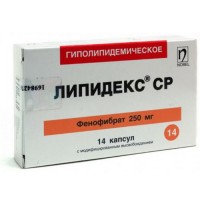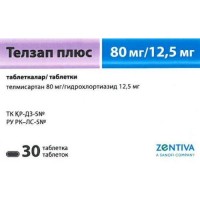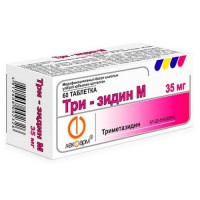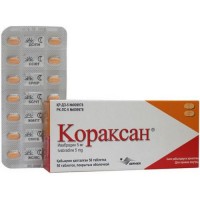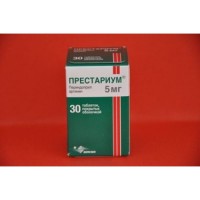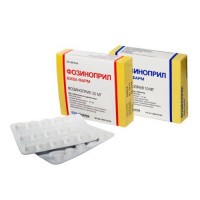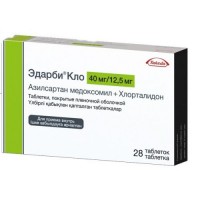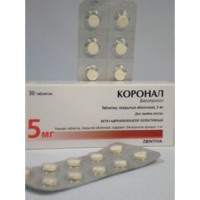Digoxin 0.25 mg (40 tablets)
- $2.50
Out Of Stock
Pharmacological action: Treats to group of cardiac glycosides. Drug is received from a herb a foxglove woolly (Digitalis lanata Ehrh.). Possesses the following actions: inotropic, vasodilating and moderate diuretic.
Increases shock and systolic volumes of heart, raises the refractory period, reduces atrioventricular conductivity, reduces the frequency of reductions of a cardiac muscle. In case of developments of stagnation at cardiovascular insufficiency has the significant vasodilating effect. Digoxin has soft diuretic effect, reduces severity of hypostases, asthmas. At overdose it is capable to initiate increase in excitability of a myocardium therefore disturbances of a heart rhythm are observed.
At intake, digoxin quickly, is almost completely absorbed from digestive tract. The bioavailability of drug is 60-70%. In 60 minutes after oral administration in blood the therapeutic concentration of drug is already observed. Cmax in blood plasma is reached in 1.5 hours after introduction. Elimination half-life of digoxin depends on several factors: possible changes of functions of kidneys, from age. At patients of young age the elimination half-life makes 36 hours, at elderly – 68 hours. 80% of drug by kidneys in not changed look Eliminirutsya.
At a concomitant use of food and digoxin the drug absorption reduction is observed, but extent of absorption does not change. In case of a prevalence in food of fibers (bran) digoxin absorption considerably worsens.
Indications: • Chronic cardiovascular insufficiency (congestive), • a tachyarrhythmia (paroxysmal supraventricular) – in an atrial fibrillation, atrial fibrillation, a Bouveret's disease.
Route of administration: The dose of digoxin is selected by the doctor individually. The single dose of drug makes 0.00025 g (for adults) – 1 tablet on 0.25 mg. In the first day of therapy apply 4-5 times/days with the intervals equal among themselves. The daily dose at the same time makes 1-1.25 mg. Next day appoint the same single dose, but 1-3 times/days. The positive effect is estimated according to electrocardiography, functions of breath, urination. Depending on it it is possible either to increase a dosage of digoxin, or to reduce. After approach of therapeutic effect, drug is appointed according to the scheme: 0.5-0.25-0.125 mg (in the morning – 2 tablets, during the lunchtime – 1 tablet, for the night – a half of a tablet). For adults the highest dose in day makes 1.5 mg (0.0015 g).
At cardiovascular insufficiency appoint digoxin from reception supporting (0.125-0.25 mg a day) doses. In arrhythmia at the beginning of therapy it is possible to use higher dosages – 0.375-0.5 mg/days. At a sinoatrial rate digoxin is not used in high doses (0.25 mg/days). In pediatrics the selection of a dose is carried out individually. The approximate saturating daily dosage – 0.05-0.08 mg on kilogram of body weight. This dosage is used for fast digitalization (1-2 days), average (3-5 days) or slow (6-7 days).
Side effects: Cardiovascular system: changes of a heart rhythm (overdose phenomena). Digestive tract: vomiting, nausea, loss of appetite, diarrhea. Central nervous system: fatigue, general weakness, apathy, head pains, photophobia, diplopia, depression, flashing of front sights, psychosis. Endocrine system: a gynecomastia at long administration of drug. System of blood and hemopoiesis: petechias, thrombocytopenia. Allergic reactions: itching, urticaria.
Side effects most often are signs of overdose of a digitalis.
Contraindications: Digoxin is contraindicated in unstable stenocardia, intoxication glycosides, a cardiac tamponade, disturbances of a heart rhythm (fibrillation of ventricles, the profound bradycardia, atrioventricular block, premature ventricular contraction, ventricular tachycardia), the mitral stenosis (isolated) of Wolf-Parkinson-Whyte a syndrome (WPW), individual hypersensitivity to digoxin drugs, a subaortal hypertrophic stenosis, a myocardial infarction in the acute stage.
Pregnancy: This drug is capable to get through a gematoplatsentarny barrier, in blood plasma at a fruit is defined in the same concentration, as at the pregnant woman. It is excreted with breast milk slightly. However at a lactation against the background of intake of digoxin the monitoring of ChSS at the child is necessary. Teratogenic potential in clinical trials is not revealed, however it is necessary to appoint digoxin for pregnant women only when exceeding advantage of reception over probable risks for a fruit or the child.
Interaction with other medicines: It is incompatible with salts of metals, acids, alkalis and tannins. At a combination with diuretic, glucocorticosteroids, insulin, sympathomimetics, drugs of salts of calcium the likelihood of developing glikozidny intoxication raises.
In combination with quinidine, erythromycin, with Amiodaronum, verapamil the increase in concentration of drug in blood is observed. Quinidine reduces digoxin removal that increases its content in blood.
The renal clearance of digoxin can decrease at a concomitant use of verapamil. However this effect decreases at long intake of both drugs (5-6 weeks). Both verapamil, and quinidine can force out digoxin from places of binding therefore in an initiation of treatment perhaps sharp increase in concentration of digoxin in blood plasma. At reception continuation the concentration of drug is stabilized at the level which depends on clearance of a digitalis.
In a combination with Amphotericinum B the risk of overdose increases because Amphotericinum B causes a hypopotassemia. Increase in concentration of calcium in blood serum increases sensitivity of a cardiac muscle therefore the drugs of calcium should not be administered intravenously to the patients accepting cardiac glycosides.
At a combination to reserpine, Phenytoinum, propranolol the risk of developing arrhythmia increases. Reduce concentration in digoxin blood phenylbutazone and drugs of a barbituric row (as a result, its efficiency decreases). Antacids, potassium drugs, Metoclopramidum and Neomycinum reduce medical effect. At a combination with gentamycin, erythromycin the concentration of drug in blood plasma increases.
The concomitant use with holestiraminy, holestipoly, magnesian laxatives, antacids, Metoclopramidum absorption of digoxin from digestive tract goes down (also decrease in concentration of digoxin in blood is observed).
Metabolism of drug amplifies at a combination with Sulfasalazinum and rifampicin, as a result, decrease in concentration of digoxin in blood plasma is observed.
Overdose: Symptoms of overdose appear in glikozidny intoxication. It is characterized by appearance of sinus bradycardia, ventricular extrasystoles as a bigeminal pulse, atrial tachycardia, fibrillation of ventricles, delay of atrioventricular conductivity, atrioventricular block. Among symptoms of glikozidny intoxication there are also extracardiac: dyspepsias (diarrhea, vomiting or nausea, anorexia), memory loss, drowsiness, head pains, weakness in muscles, erectile dysfunction, a gynecomastia, psychosis, concern, euphoria, flashing of front sights before eyes, a xanthopsia, scotomas, decrease in visual acuity, micro and a macropsia. At advanced age the confusion of consciousness, a depression can be observed.
If symptoms are expressed slightly – it is necessary to reduce a digoxin dose. In case of progressing or the significant side effects take a small break (if administration of drug has to be continued). Duration of a break depends on expressiveness of symptoms of intoxication digoxin.
In case of acute poisoning with digoxin appoint gastric lavage water with addition of the coal activated or enterosorbents, further use these drugs orally. Appoint laxatives (salt: magnesium sulfate, sodium sulfate - to dissolve 15-30.0 g of salt laxative in 250 ml of warm water).
In case of development the arrhythmia can be stopped intravenous drop infusion of potassium chloride (2-2.4 g) with insulin addition (10 PIECES). These components add to 500 ml of a dextrose and enter before achievement of potassium concentration in blood serum 3 mekv/l. Administration of potassium is categorically contraindicated at disturbance of atrioventricular conductivity. If the antiarrhytmic effect did not manage to achieve, it is possible to enter intravenously Phenytoinum in calculation of 0.0005 g/kg of weight of the patient, to carry out introduction with an interval 1-2 hours. Atropini sulfas is shown in the profound bradycardia. Appoint also oxygenotherapy, in hypotension – volemichesky drugs. As antidote it is possible to use Unithiolum.
Packaging: Tablets of white color on 0.00025 mg, the cardboard pack contains 2 blisters on 20 tablets everyone.
Storage conditions: To store no more than 5 years at a temperature not above 25 °C.
Ingredients: Active ingredient: digoxin. Inactive ingredients: talc, glucose, sugar, liquid paraffin, starch, calcium stearate.
In addition: When prescribing digoxin the patient has to be under control of medical staff. At long-term treatment the optimum dosage is selected individually within 7-10 days. It is necessary to remember that an interval between therapeutic and toxic doses at digoxin very insignificant. Therefore, the patient has to follow doctor's instructions strictly.
The risk of intoxication a digitalis increases at decrease in level of potassium in blood, at strong dilatation of a myocardium, an alkalosis, a pulmonary heart, myocarditis, at elderly patients. The risk of intoxication digoxin also increases in case of a hypercalcemia, a hypomagnesiemia, a hypernatremia, a hypothyroidism. In need of transition to strophanthin the last is appointed not earlier than day after the last intake of digoxin. In case of a combination of saluretics with digoxin it is necessary to appoint potassium drugs as its decrease in blood exponentiates toxic effects of a digitalis.
In case of a renal failure it is necessary to lower a drug dose (25-75% of a usual dose – at glomerular filtration less than 50 ml/min., 10-25% of a usual dose – at glomerular filtration less than 10 ml/min.).
During intake of digoxin the regular control of an elekstrokardiografiya and determination of electrolytic balance (magnesium, potassium, calcium) in blood serum is required. Patients are warned that meal, rich in vegetable fibers hard to digest and pectins is reduced by effects of digoxin.
Attention! The description of the drug 'Digoxin' on this page is the official instruction for use simplified and supplemented with the version. Before acquisition or use of drug you have to consult with the doctor and study the summary approved by producer. Information on drug is provided only with the fact-finding purpose and should not be used as the management to self-treatment. Only the doctor can make the decision on prescribing of drug and also define doses and ways of its use.
To develop
Increases shock and systolic volumes of heart, raises the refractory period, reduces atrioventricular conductivity, reduces the frequency of reductions of a cardiac muscle. In case of developments of stagnation at cardiovascular insufficiency has the significant vasodilating effect. Digoxin has soft diuretic effect, reduces severity of hypostases, asthmas. At overdose it is capable to initiate increase in excitability of a myocardium therefore disturbances of a heart rhythm are observed.
At intake, digoxin quickly, is almost completely absorbed from digestive tract. The bioavailability of drug is 60-70%. In 60 minutes after oral administration in blood the therapeutic concentration of drug is already observed. Cmax in blood plasma is reached in 1.5 hours after introduction. Elimination half-life of digoxin depends on several factors: possible changes of functions of kidneys, from age. At patients of young age the elimination half-life makes 36 hours, at elderly – 68 hours. 80% of drug by kidneys in not changed look Eliminirutsya.
At a concomitant use of food and digoxin the drug absorption reduction is observed, but extent of absorption does not change. In case of a prevalence in food of fibers (bran) digoxin absorption considerably worsens.
Indications: • Chronic cardiovascular insufficiency (congestive), • a tachyarrhythmia (paroxysmal supraventricular) – in an atrial fibrillation, atrial fibrillation, a Bouveret's disease.
Route of administration: The dose of digoxin is selected by the doctor individually. The single dose of drug makes 0.00025 g (for adults) – 1 tablet on 0.25 mg. In the first day of therapy apply 4-5 times/days with the intervals equal among themselves. The daily dose at the same time makes 1-1.25 mg. Next day appoint the same single dose, but 1-3 times/days. The positive effect is estimated according to electrocardiography, functions of breath, urination. Depending on it it is possible either to increase a dosage of digoxin, or to reduce. After approach of therapeutic effect, drug is appointed according to the scheme: 0.5-0.25-0.125 mg (in the morning – 2 tablets, during the lunchtime – 1 tablet, for the night – a half of a tablet). For adults the highest dose in day makes 1.5 mg (0.0015 g).
At cardiovascular insufficiency appoint digoxin from reception supporting (0.125-0.25 mg a day) doses. In arrhythmia at the beginning of therapy it is possible to use higher dosages – 0.375-0.5 mg/days. At a sinoatrial rate digoxin is not used in high doses (0.25 mg/days). In pediatrics the selection of a dose is carried out individually. The approximate saturating daily dosage – 0.05-0.08 mg on kilogram of body weight. This dosage is used for fast digitalization (1-2 days), average (3-5 days) or slow (6-7 days).
Side effects: Cardiovascular system: changes of a heart rhythm (overdose phenomena). Digestive tract: vomiting, nausea, loss of appetite, diarrhea. Central nervous system: fatigue, general weakness, apathy, head pains, photophobia, diplopia, depression, flashing of front sights, psychosis. Endocrine system: a gynecomastia at long administration of drug. System of blood and hemopoiesis: petechias, thrombocytopenia. Allergic reactions: itching, urticaria.
Side effects most often are signs of overdose of a digitalis.
Contraindications: Digoxin is contraindicated in unstable stenocardia, intoxication glycosides, a cardiac tamponade, disturbances of a heart rhythm (fibrillation of ventricles, the profound bradycardia, atrioventricular block, premature ventricular contraction, ventricular tachycardia), the mitral stenosis (isolated) of Wolf-Parkinson-Whyte a syndrome (WPW), individual hypersensitivity to digoxin drugs, a subaortal hypertrophic stenosis, a myocardial infarction in the acute stage.
Pregnancy: This drug is capable to get through a gematoplatsentarny barrier, in blood plasma at a fruit is defined in the same concentration, as at the pregnant woman. It is excreted with breast milk slightly. However at a lactation against the background of intake of digoxin the monitoring of ChSS at the child is necessary. Teratogenic potential in clinical trials is not revealed, however it is necessary to appoint digoxin for pregnant women only when exceeding advantage of reception over probable risks for a fruit or the child.
Interaction with other medicines: It is incompatible with salts of metals, acids, alkalis and tannins. At a combination with diuretic, glucocorticosteroids, insulin, sympathomimetics, drugs of salts of calcium the likelihood of developing glikozidny intoxication raises.
In combination with quinidine, erythromycin, with Amiodaronum, verapamil the increase in concentration of drug in blood is observed. Quinidine reduces digoxin removal that increases its content in blood.
The renal clearance of digoxin can decrease at a concomitant use of verapamil. However this effect decreases at long intake of both drugs (5-6 weeks). Both verapamil, and quinidine can force out digoxin from places of binding therefore in an initiation of treatment perhaps sharp increase in concentration of digoxin in blood plasma. At reception continuation the concentration of drug is stabilized at the level which depends on clearance of a digitalis.
In a combination with Amphotericinum B the risk of overdose increases because Amphotericinum B causes a hypopotassemia. Increase in concentration of calcium in blood serum increases sensitivity of a cardiac muscle therefore the drugs of calcium should not be administered intravenously to the patients accepting cardiac glycosides.
At a combination to reserpine, Phenytoinum, propranolol the risk of developing arrhythmia increases. Reduce concentration in digoxin blood phenylbutazone and drugs of a barbituric row (as a result, its efficiency decreases). Antacids, potassium drugs, Metoclopramidum and Neomycinum reduce medical effect. At a combination with gentamycin, erythromycin the concentration of drug in blood plasma increases.
The concomitant use with holestiraminy, holestipoly, magnesian laxatives, antacids, Metoclopramidum absorption of digoxin from digestive tract goes down (also decrease in concentration of digoxin in blood is observed).
Metabolism of drug amplifies at a combination with Sulfasalazinum and rifampicin, as a result, decrease in concentration of digoxin in blood plasma is observed.
Overdose: Symptoms of overdose appear in glikozidny intoxication. It is characterized by appearance of sinus bradycardia, ventricular extrasystoles as a bigeminal pulse, atrial tachycardia, fibrillation of ventricles, delay of atrioventricular conductivity, atrioventricular block. Among symptoms of glikozidny intoxication there are also extracardiac: dyspepsias (diarrhea, vomiting or nausea, anorexia), memory loss, drowsiness, head pains, weakness in muscles, erectile dysfunction, a gynecomastia, psychosis, concern, euphoria, flashing of front sights before eyes, a xanthopsia, scotomas, decrease in visual acuity, micro and a macropsia. At advanced age the confusion of consciousness, a depression can be observed.
If symptoms are expressed slightly – it is necessary to reduce a digoxin dose. In case of progressing or the significant side effects take a small break (if administration of drug has to be continued). Duration of a break depends on expressiveness of symptoms of intoxication digoxin.
In case of acute poisoning with digoxin appoint gastric lavage water with addition of the coal activated or enterosorbents, further use these drugs orally. Appoint laxatives (salt: magnesium sulfate, sodium sulfate - to dissolve 15-30.0 g of salt laxative in 250 ml of warm water).
In case of development the arrhythmia can be stopped intravenous drop infusion of potassium chloride (2-2.4 g) with insulin addition (10 PIECES). These components add to 500 ml of a dextrose and enter before achievement of potassium concentration in blood serum 3 mekv/l. Administration of potassium is categorically contraindicated at disturbance of atrioventricular conductivity. If the antiarrhytmic effect did not manage to achieve, it is possible to enter intravenously Phenytoinum in calculation of 0.0005 g/kg of weight of the patient, to carry out introduction with an interval 1-2 hours. Atropini sulfas is shown in the profound bradycardia. Appoint also oxygenotherapy, in hypotension – volemichesky drugs. As antidote it is possible to use Unithiolum.
Packaging: Tablets of white color on 0.00025 mg, the cardboard pack contains 2 blisters on 20 tablets everyone.
Storage conditions: To store no more than 5 years at a temperature not above 25 °C.
Ingredients: Active ingredient: digoxin. Inactive ingredients: talc, glucose, sugar, liquid paraffin, starch, calcium stearate.
In addition: When prescribing digoxin the patient has to be under control of medical staff. At long-term treatment the optimum dosage is selected individually within 7-10 days. It is necessary to remember that an interval between therapeutic and toxic doses at digoxin very insignificant. Therefore, the patient has to follow doctor's instructions strictly.
The risk of intoxication a digitalis increases at decrease in level of potassium in blood, at strong dilatation of a myocardium, an alkalosis, a pulmonary heart, myocarditis, at elderly patients. The risk of intoxication digoxin also increases in case of a hypercalcemia, a hypomagnesiemia, a hypernatremia, a hypothyroidism. In need of transition to strophanthin the last is appointed not earlier than day after the last intake of digoxin. In case of a combination of saluretics with digoxin it is necessary to appoint potassium drugs as its decrease in blood exponentiates toxic effects of a digitalis.
In case of a renal failure it is necessary to lower a drug dose (25-75% of a usual dose – at glomerular filtration less than 50 ml/min., 10-25% of a usual dose – at glomerular filtration less than 10 ml/min.).
During intake of digoxin the regular control of an elekstrokardiografiya and determination of electrolytic balance (magnesium, potassium, calcium) in blood serum is required. Patients are warned that meal, rich in vegetable fibers hard to digest and pectins is reduced by effects of digoxin.
Attention! The description of the drug 'Digoxin' on this page is the official instruction for use simplified and supplemented with the version. Before acquisition or use of drug you have to consult with the doctor and study the summary approved by producer. Information on drug is provided only with the fact-finding purpose and should not be used as the management to self-treatment. Only the doctor can make the decision on prescribing of drug and also define doses and ways of its use.
To develop

